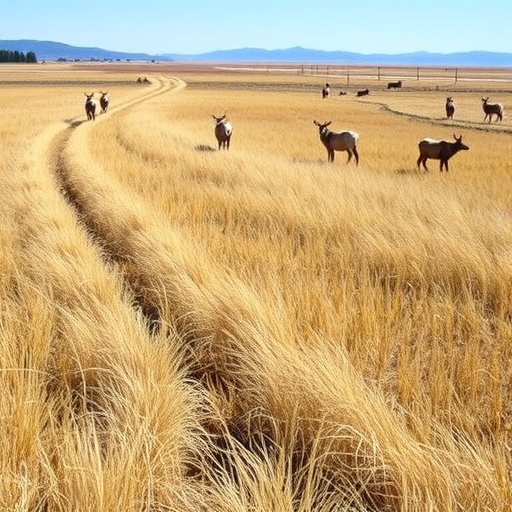Grasslands stand as formidable ecosystems that have evolved mechanisms to cope with variability in water availability, yet they face unprecedented challenges as drought conditions intensify and stretch across lengthening timescales. A groundbreaking international study published in Science delves into how grasslands worldwide navigate the interplay between drought intensity and duration, illuminating critical implications for global biogeochemical cycles and ecosystem resilience. This research brings to light nuanced responses of plant communities under prolonged water stress, authored by more than 180 global collaborators including Binghamton University’s Assistant Professor Amber Churchill.
The experiment leveraged a distributed network approach, harnessing coordinated efforts across diverse grassland sites to apply standardized drought treatments and produce comparable data sets. Each site maintained independent stewardship over data gathering, ensuring ecological and methodological rigor while fostering a collaborative scientific ecosystem. This standardized yet localized methodology allowed scientists to discern patterns of primary productivity shifts, specifically plant biomass accumulation, in response to differential precipitation reductions.
Productivity—the measure of biomass growth within a year—is fundamentally affected by water availability. However, the research reveals the complexity underlying this relationship. Not all grasslands experience drought equivalently; aridity gradients modulate drought impact significantly. For example, a 10% decrease in rainfall within an arid grassland context can equate to the relative severity of a 40% reduction in a more mesic ecosystem. This variability necessitates location-specific interpretations when assessing drought consequences and projecting future ecosystem functionality.
One focal point of Churchill’s contribution centers on the oak savannah located at the Cedar Creek Ecosystem Science Reserve in Minnesota. This biome uniquely integrates grassland and forest elements, characterized by widely spaced oak trees with grass understories. Fire and bison grazing historically maintained the structural integrity of these savannahs, which now face fragmentation and decline, accounting for only a fraction of their historic extent due to agricultural expansion and urbanization. Such ecosystems are critical for studying drought responses because their dual character influences carbon dynamics and biodiversity interactions.
The study’s findings underscore a dichotomy in grassland responses to drought severity. Moderate drought conditions lead to a dynamic equilibrium wherein drought-sensitive species recede, replaced by drought-tolerant taxa, thereby preserving overall biomass despite altered species composition. This acclimatization phenomenon is pivotal in maintaining ecosystem services over extended dry periods, highlighting the importance of species identity beyond sheer biodiversity counts.
Conversely, extreme droughts trigger stark reductions in plant abundance and a contraction of species diversity. Historically rare events occurring once per century, these intense droughts are becoming more frequent due to anthropogenic climate change. The ramifications extend beyond localized biomass loss, threatening the stability of grassland carbon sequestration and thus feeding into broader climate feedback loops. This intensification is alarming for future projections of ecosystem productivity and carbon cycling on a global scale.
Moreover, Churchill notes that while northeastern U.S. grasslands, including urban lawns, experience relatively shorter dry spells, their concerns pivot toward hydrological excess rather than deficiency. This shift directs her current research focus onto how biodiversity can serve as a buffer against flooding impacts, emphasizing the interconnectedness of water regime extremes and ecosystem health.
The collaborative nature of this research has catalyzed the formation of a global community of grassland drought experts. Despite geographical distances, the network’s synergy emerges through data sharing, peer-review refinement, and intellectual exchange, a model exemplifying modern scientific collaboration’s power in tackling global environmental challenges. This ‘ecosystem of scientists’ fosters rapid knowledge dissemination, adaptability to emergent questions, and cross-disciplinary innovation.
Intriguingly, the study contrasts grassland responsiveness with forest ecosystems. Grasslands exhibit greater year-to-year variability in carbon uptake, reflecting opportunistic growth patterns in response to climatic fluctuations. Forests, by contrast, generally sequester carbon more steadily across seasons, suggesting differing resilience mechanisms among biomes with profound implications for carbon budgeting and climate models.
Significantly, at Cedar Creek, the initial year of the experiment coincided with an extreme drought event, providing a real-world stress test for grassland resilience. Subsequent moderate drought conditions facilitated ecosystem recovery, allowing researchers to observe the trajectories of ecological rebound and community reassembly post-disturbance. These temporal dynamics are critical for forecasting ecosystem trajectories under shifting climate regimes.
The study’s integration of ecological theory with empirical data advances understanding of how droughts of varying intensities and durations shape primary productivity. The recognition that drought-acclimated communities differ functionally and compositionally from pre-drought assemblages informs management practices. It calls for preserving or restoring drought-resilient species to bolster ecosystem stability amidst increasing climatic variability.
As droughts intensify globally, this research provides a timely framework for understanding and anticipating grassland ecosystem responses. It underscores the necessity of sustained, coordinated global monitoring coupled with localized ecological expertise, positioning distributed networks as indispensable in addressing multifaceted environmental crises. Grasslands, often overlooked, emerge as critical nodes within the planet’s carbon and water cycles, warranting heightened scientific and conservation attention.
Subject of Research: Grassland ecosystem responses to varying drought intensities and durations affecting primary productivity and species composition.
Article Title: Drought intensity and duration interact to magnify losses in primary productivity
News Publication Date: Not specified
Web References: http://dx.doi.org/10.1126/science.ads8144
Image Credits: Cedar Creek Ecosystem Science Reserve, CC BY-SA 3.0, via Wikimedia Commons
Keywords: Droughts; Natural disasters; Earth sciences; Plant ecology; Plant communities; Community ecology; Environmental sciences; Ecology; Life sciences; Plant sciences; Plants; Ecosystems; Grassland ecosystems; Biomes




